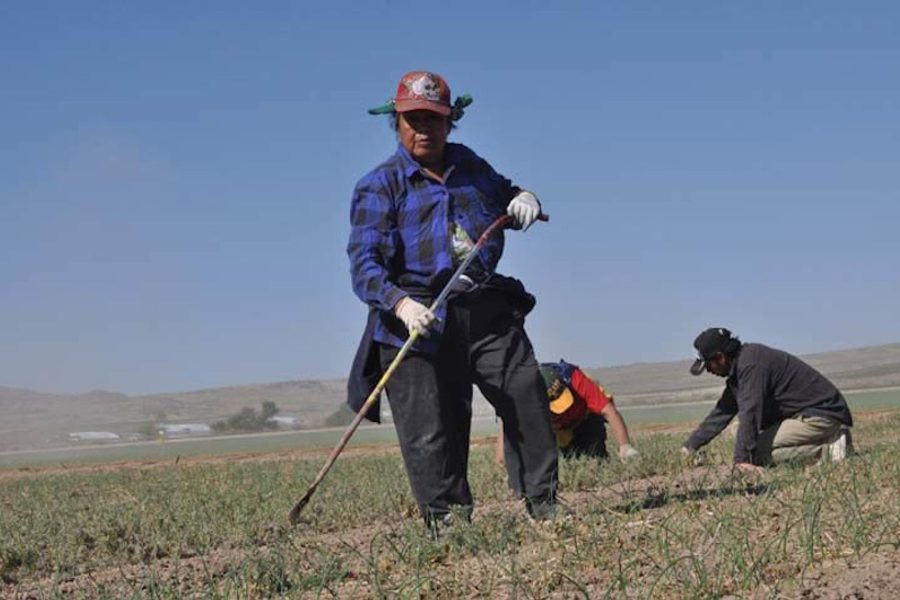A Victory for New Mexico’s Chileros
Farmers must pay chile pickers 25 cents more per hour, state says.
Joseph Sorrentino

Chile pickers in New Mexico who perform work that is as precarious as it is exhausting — and who are victims of an epidemic of wage theft, as In These Times reported in December — have won a tentative victory. For years, contratistas (labor contractors) and growers in New Mexico believed they were exempt from paying farmworkers the state’s minimum wage of $7.50 an hour. Instead, they routinely paid the federal minimum wage of $7.25 an hour. But after some prodding by advocates, New Mexico’s Department of Workforce Solutions (DWS) sent a letter this February to all the registered contratistas and growers in the state, informing them that workers must be paid 25 cents more an hour.
Tess Wilkes, an attorney at the New Mexico Center for Law and Poverty (NMCLP), noticed that most workers were being paid the lower wage when she was a law student a few years ago. “I first saw it on worker paystubs,” she says. Last summer, the issue really hit home for her when she was in the fields and realized that even people who believed they were in compliance with the law weren’t paying workers adequately. “It wasn’t just a bad receipt or a rare case,” she continues. “[A contratista] brought us a poster to show us what he displayed [for workers], and it was the federal minimum wage of $7.25.” María Martínez Sánchez, another attorney at NMCLP, sent a letter to DWS informing them that, according to her legal analysis, workers should be paid at least the state minimum wage of $7.50 an hour. Their General Council agreed and Jason Dean, the Division Director of the Labor Relations Division at DWS, sent out the letter. (In the course of reporting on wage theft last year, In These Times reviewed many wage receipts, and every one of them listed $7.25 as the hourly wage. It was only this year, at one farm, that this reporter finally found an employer paying $7.50 an hour).
While there are exemptions in the New Mexico Minimum Wage Act for small farms that employ very few workers, somehow growers and contratistas came to believe that the entire agriculture industry in New Mexico was exempt from paying the state’s minimum wage. Although the increase means only a few dollars a week more for a worker, it does have an impact.
“Farmworkers in this region tend to operate on a very slim margin,” says Sarah Rich, an attorney at the nonprofit Texas Rio Grande Legal Aid in El Paso. “They have very little room for error in their budget, so any extra money is helpful.”
Antonio Zubia Hernández, a 62-year-old farmworker with a Pancho Villa moustache, put it this way: “A few more dollars a week means a little more food for one…It can mean enough food for one day.” For Antonio, that meant, “Two burritos for breakfast, two for lunch and two for dinner.”
While the increase may be a modest one for workers, it’s far from insignificant for contratistas and growers. For a moderately-sized crew — say 50 people, working eight hours a day for six days a week — that $2 a day translates to $600 a week that the contratista were saving — or stealing, depending on one’s point of view.
The DWS letter also addressed another, perhaps more significant, way that farmworkers routinely have their wages stolen.
Many farmworkers in southern New Mexico live in El Paso, Texas. During the summer’s chile harvest, they’re typically on the streets of that city by 2 a.m., hoping to be hired by a contratista who will then drive them to farms in New Mexico. They’ll often arrive at the farms an hour or more before sunrise; it’s too dark to pick chiles so they sit on the bus or in a van and wait. Although federal law states that they must be paid for the time they spend waiting, they virtually never are. “[The employer] has chosen to … get them to the field at 5 a.m. and then make them sit around until it’s light enough to work,” says Rich. “That’s an employer’s choice and the employer can pay for that choice. These peoples’ time is not worthless.”
The DWS letter states: “Finally, employers should be reminded that employees who are transported to the fields and then not allowed to begin work are entitled to be paid the state minimum wage of $7.50/hour for the entire time they are present at the work site.”
In addition to the wait time at the start of their day, workers must wait at the end of the day to be paid, a wait that often stretches to well over an hour. Assuming wait times are two hours a day, six days a week, they could potentially earn an extra $90 a week in the fields. That’s a huge amount for workers routinely grossing $58 a day.
The growing season is just beginning in New Mexico. There’s little work and few workers in the fields right now, so it’s unclear whether workers are being paid the higher wage. The letter from Dean warned that DWS would be conducting random audits to determine if employers were being paid correctly. Only time, and vigilance, will tell.







